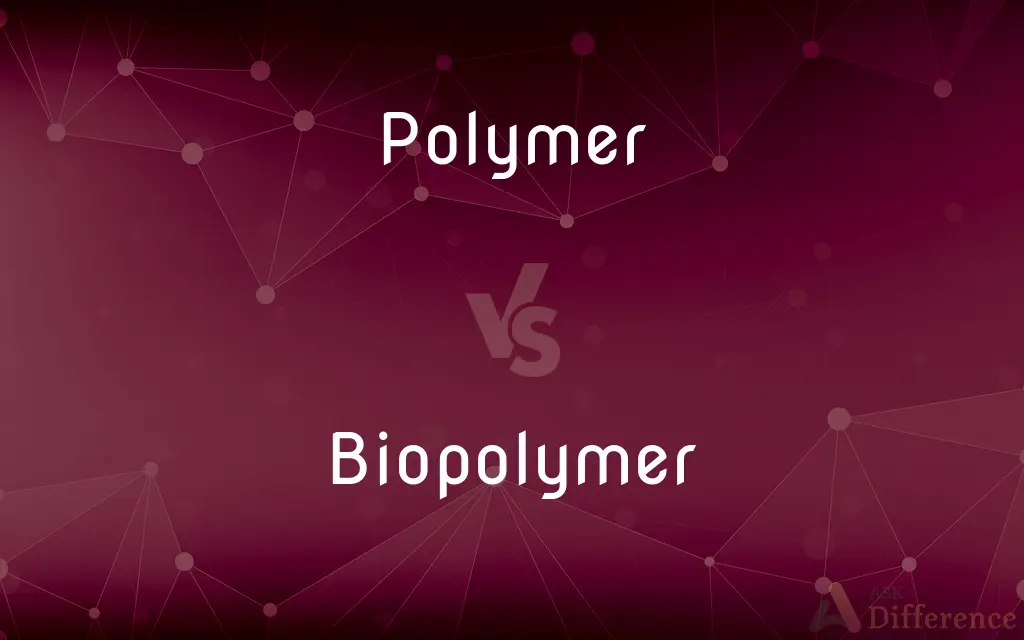Polymer vs. Biopolymer — What's the Difference?
Edited by Tayyaba Rehman — By Fiza Rafique — Published on October 26, 2023
A polymer is a large molecule made up of repeating subunits, while a biopolymer is a polymer derived from living organisms, often biodegradable.

Difference Between Polymer and Biopolymer
Table of Contents
ADVERTISEMENT
Key Differences
Polymers are macromolecules composed of smaller, repeating structures known as monomers. Biopolymers, on the other hand, are polymers produced by living organisms and include proteins, nucleic acids, and polysaccharides.
The origin of polymers can be both natural and synthetic, such as plastics. Biopolymers always have a biological origin, ensuring their compatibility with living systems.
While many polymers, especially synthetic ones, can persist in the environment, biopolymers typically degrade more quickly and are often biodegradable, aligning with ecological considerations.
The versatility of polymers allows them to be used in countless applications, from packaging to electronics. Biopolymers, given their natural origin, often serve specific biological functions or are utilized in green, sustainable applications.
Polymers have revolutionized industries, leading to the development of lightweight, durable materials. Biopolymers, capturing scientific interest, promise eco-friendliness and a reduction in pollution, presenting a sustainable alternative to traditional polymers.
ADVERTISEMENT
Comparison Chart
Origin
Natural or synthetic
Biological
Biodegradability
Varies, many are non-biodegradable
Typically biodegradable
Common Types
Polyethylene, polypropylene
Cellulose, DNA, proteins
Environmental Impact
Can be persistent pollutants
Generally eco-friendly
Typical Applications
Packaging, automotive, electronics
Medical applications, green packaging, bio-textiles
Compare with Definitions
Polymer
Material formed by chemical reactions linking monomers.
The creation of polymer chains is pivotal in plastic manufacturing.
Biopolymer
A polymer produced by living organisms.
DNA is a biopolymer carrying genetic information.
Polymer
Can be either natural or synthetic.
Rubber is a natural polymer, while polystyrene is synthetic.
Biopolymer
Often biodegradable and eco-friendly.
Polylactic acid is a biopolymer used in compostable packaging.
Polymer
A large molecule composed of repeating monomers.
Nylon is a well-known synthetic polymer used in textiles.
Biopolymer
Includes proteins, nucleic acids, and polysaccharides.
Collagen, a biopolymer, provides structural support in skin and tissues.
Polymer
Substance with high molecular weight.
The strength of polymers comes from their molecular structure.
Biopolymer
Natural polymer with specific biological functions.
Starch, a biopolymer, is a storage molecule in plants.
Polymer
Can have various properties based on structure.
The flexibility of a polymer is determined by its molecular arrangement.
Biopolymer
Utilized in sustainable, green applications.
Biopolymers have potential in reducing plastic waste in the environment.
Polymer
A polymer (; Greek poly-, "many" + -mer, "part") is a substance or material consisting of very large molecules, or macromolecules, composed of many repeating subunits. Due to their broad spectrum of properties, both synthetic and natural polymers play essential and ubiquitous roles in everyday life.
Biopolymer
A macromolecule in a living organism that is formed by linking together several smaller molecules, as a protein from amino acids or DNA from nucleotides.
Polymer
Any of numerous natural and synthetic compounds of usually high molecular weight consisting of up to millions of repeated linked units, each a relatively light and simple molecule.
Biopolymer
(biochemistry) Any macromolecule of a living organism that is formed from the polymerization of smaller entities; a polymer that occurs in a living organism or results from life.
Polymer
(organic chemistry) A long or larger molecule consisting of a chain or network of many repeating units, formed by chemically bonding together many identical or similar small molecules called monomers. A polymer is formed by polymerization, the joining of many monomer molecules.
Polymer
A material consisting of such polymer molecules.
Polymer
Any one of two or more substances related to each other by polymerism; specifically, a substance produced from another substance by chemical polymerization.
Polymer
A naturally occurring or synthetic compound consisting of large molecules made up of a linked series of repeated simple monomers
Common Curiosities
What are some examples of biopolymers?
Examples include DNA, proteins, and cellulose.
What is a polymer?
A polymer is a large molecule composed of repeating subunits called monomers.
How is a biopolymer different?
A biopolymer is a polymer derived from living organisms and is often biodegradable.
Are plastics considered polymers?
Yes, plastics are synthetic polymers.
Can polymers be found naturally?
Yes, examples include rubber and cellulose.
Is biopolymer use limited to packaging?
No, biopolymers also have medical, agricultural, and textile applications.
What is the main source of synthetic polymers?
They are typically derived from petrochemicals.
Are all biopolymers safe for the environment?
While many are biodegradable and eco-friendly, their environmental impact varies.
Are all polymers biodegradable?
No, many polymers, especially synthetics, are not biodegradable.
Why are biopolymers gaining attention?
Biopolymers are eco-friendly, reduce pollution, and offer sustainable alternatives.
How are polymers typically processed?
They can be molded, extruded, or spun into fibers.
What's a common use of biopolymers in medicine?
Biopolymers can be used in drug delivery and tissue engineering.
Are there challenges with biopolymer production?
Yes, including cost, scalability, and performance in certain applications.
Why are some polymers non-biodegradable?
Their chemical structure can resist microbial breakdown, causing persistence.
Do biopolymers play roles in the human body?
Yes, for instance, proteins and DNA are biopolymers essential for life.
Share Your Discovery

Previous Comparison
Green Crack vs. Blue Dream
Next Comparison
Educational Technology vs. Information TechnologyAuthor Spotlight
Written by
Fiza RafiqueFiza Rafique is a skilled content writer at AskDifference.com, where she meticulously refines and enhances written pieces. Drawing from her vast editorial expertise, Fiza ensures clarity, accuracy, and precision in every article. Passionate about language, she continually seeks to elevate the quality of content for readers worldwide.
Edited by
Tayyaba RehmanTayyaba Rehman is a distinguished writer, currently serving as a primary contributor to askdifference.com. As a researcher in semantics and etymology, Tayyaba's passion for the complexity of languages and their distinctions has found a perfect home on the platform. Tayyaba delves into the intricacies of language, distinguishing between commonly confused words and phrases, thereby providing clarity for readers worldwide.












































